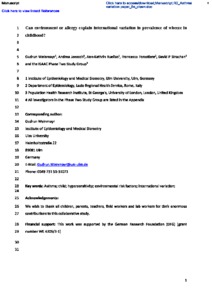Weinmayr, G; Jaensch, A; Ruelius, A-K; Forastiere, F; Strachan, DP; ISAAC Phase Two Study Group
(2019)
Can environment or allergy explain international variation in prevalence of wheeze in childhood?
EUROPEAN JOURNAL OF EPIDEMIOLOGY, 34 (5).
pp. 509-520.
ISSN 0393-2990
https://doi.org/10.1007/s10654-018-0463-z
SGUL Authors: Strachan, David Peter
![[img]](https://openaccess.sgul.ac.uk/110355/1.hassmallThumbnailVersion/EJEP-D-18-00247-R2-accepted.pdf)  Preview |
|
PDF
Accepted Version
Available under License ["licenses_description_publisher" not defined].
Download (15MB)
| Preview
|
Abstract
Asthma prevalence in children varies substantially around the world, but the contribution of known risk factors to this international variation is uncertain. The International Study of Asthma and Allergies in Childhood (ISAAC) Phase Two studied 8–12 year old children in 30 centres worldwide with parent-completed symptom and risk factor questionnaires and aeroallergen skin prick testing. We used multilevel logistic regression modelling to investigate the effect of adjustment for individual and ecological risk factors on the between-centre variation in prevalence of recent wheeze. Adjustment for single individual-level risk factors changed the centre-level variation from a reduction of up to 8.4% (and 8.5% for atopy) to an increase of up to 6.8%. Modelling the 11 most influential environmental factors among all children simultaneously, the centre-level variation changed little overall (2.4% increase). Modelling only factors that decreased the variance, the 6 most influential factors (synthetic and feather quilt, mother’s smoking, heating stoves, dampness and foam pillows) in combination resulted in a 21% reduction in variance. Ecological (centre-level) risk factors generally explained higher proportions of the variation than did individual risk factors. Single environmental factors and aeroallergen sensitisation measured at the individual (child) level did not explain much of the between-centre variation in wheeze prevalence.
Statistics
Item downloaded times since 13 Nov 2018.
Actions (login required)
 |
Edit Item |


